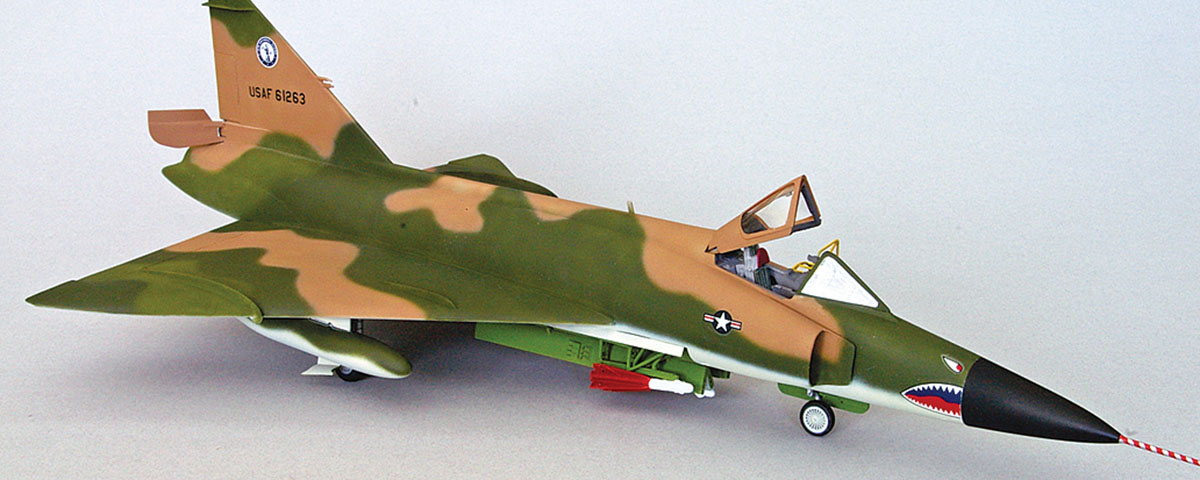America’s first supersonic interceptor evolved from the most revolutionary development specs in U.S. Air Force history. Rather than procuring an airframe and its weapons as separate items, the 1950 proposal that spawned Convair’s F-102 Delta Dagger addressed the interceptor as a weapon system, into which components would be integrated as a compatible package. The outcome was the first operational delta-wing jet fighter, a plane that became the backbone of U.S. Cold War defenses.
There are two 1/48th scale Delta Dagger kits, and it is important to note the subtle differences of whichever model you are building. In the early 1990s, Monogram Models issued a “Deuce” that contained the early “Case X” (Case Ten) wing, notable for its straight, squared-off tips. The same company later issued a second version that featured the “Case XX” (Case Twenty) wing, which curved downward at the tip (that kit is now sold by Revell of Germany). The Case XX wing replaced the earlier version on all aircraft starting with airframe 56-1317 onward and was not retrofitted. Determine which kit you have and take care in selecting appropriate markings.
Construction of the kit for the model shown above (with the Case X wing) starts with the cockpit, which should be painted overall dark gull gray (FS-26231). The instrument panel, normally black, should also be painted gray and the dials dry-brushed with black. The ejection seat cushions are dark green (FS-34096), with the belts highlighted in light gray and the headrest brushed with dark red.
Glue the completed cockpit into one side of the fuselage. Next paint the inside of the afterburner nozzles dark metallic gray, place the flame-holder ring into position and then cement the “burner” pieces together. Glue the completed afterburner into the tail area and close the fuselage sides.
The Delta Dagger was armed with a variety of missiles that were carried in a large underside bay. The weapons bay can be built in the open position with three Falcon AIM-4F radar-guided and three Falcon AIM-4G infrared missiles loaded on their launchers. This area, along with the main and nose wheel wells, should be painted zinc chromate green (FS-34227). If you choose the open bay option, be sure to follow the kit instructions carefully and be ready to exercise considerable patience. Color photos of the missiles nestled in their bay can be found on P. 38 of Bert Kinsey’s book F-102 Delta Dagger in Detail and Scale.
If you’ve constructed your model with the missile bay open, set that assembly aside and tackle the expansive delta wings. The top and bottom pieces do not fit together well and will require considerable sanding and filling. The wing-to-fuselage joint will also require filling and sanding.
Entering active service in 1956, the F-102 was deployed to Aerospace Defense Command bases in the continental United States, Alaska, Europe and the Pacific. For planes that served in this role, the airframes were painted in an overall glossy light gray known as “ADC Gray” (FS-16473), with the large delta fin adorned with bright splashes of color. In 1960 the Air National Guard began receiving Delta Daggers. Many units later painted their Deuces in the Southeast Asia camouflage scheme.
The large delta wings provide a perfect canvas on which to apply the two greens and tan irregular camouflage pattern. You can easily achieve this effect with an airbrush, but it’s also possible to get good results with a brush. Start by painting the aircraft’s undersides with camouflage gray (FS-36440). Using the drawing on the instruction sheet, lightly trace out the tri-color camouflage pattern on the topside with a soft lead pencil. Begin painting with the lightest color area first and then move on to the lighter of the two greens and finally the darker green.
My choice for markings came from a photo of an aircraft from the 190th Fighter Interceptor Squadron of the Idaho Air National Guard found on P. 39 in Kinsey’s book. That aircraft was somewhat unusual in that it sported a shark mouth on its nose. I found suitable shark teeth on Micro Scale decal sheet #48-157, which was designed for a Vietnam-era U.S. Air Force F-4E Phantom. A little trimming and some dabs of paint customized the decal for my purposes. I took the National Guard “Minuteman” decal from the Experts-Choice sheet #48-13. The small national insignia came from a Scale-Master sheet of stars and bars.
Seal the markings with a light coat of dulling spray. Attach the canopy and landing gear, and your shark-mouthed Delta Dagger will be ready for display.
Originally published in the September 2007 issue of Aviation History. To subscribe, click here.





